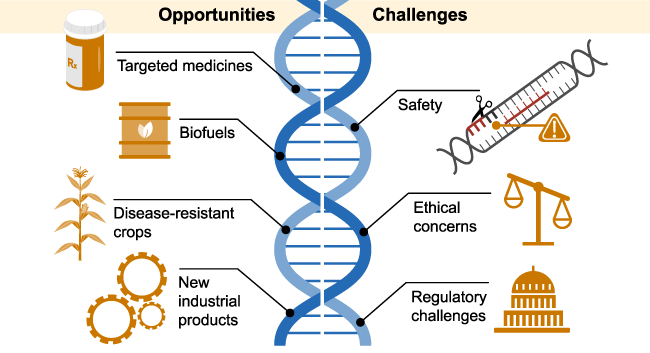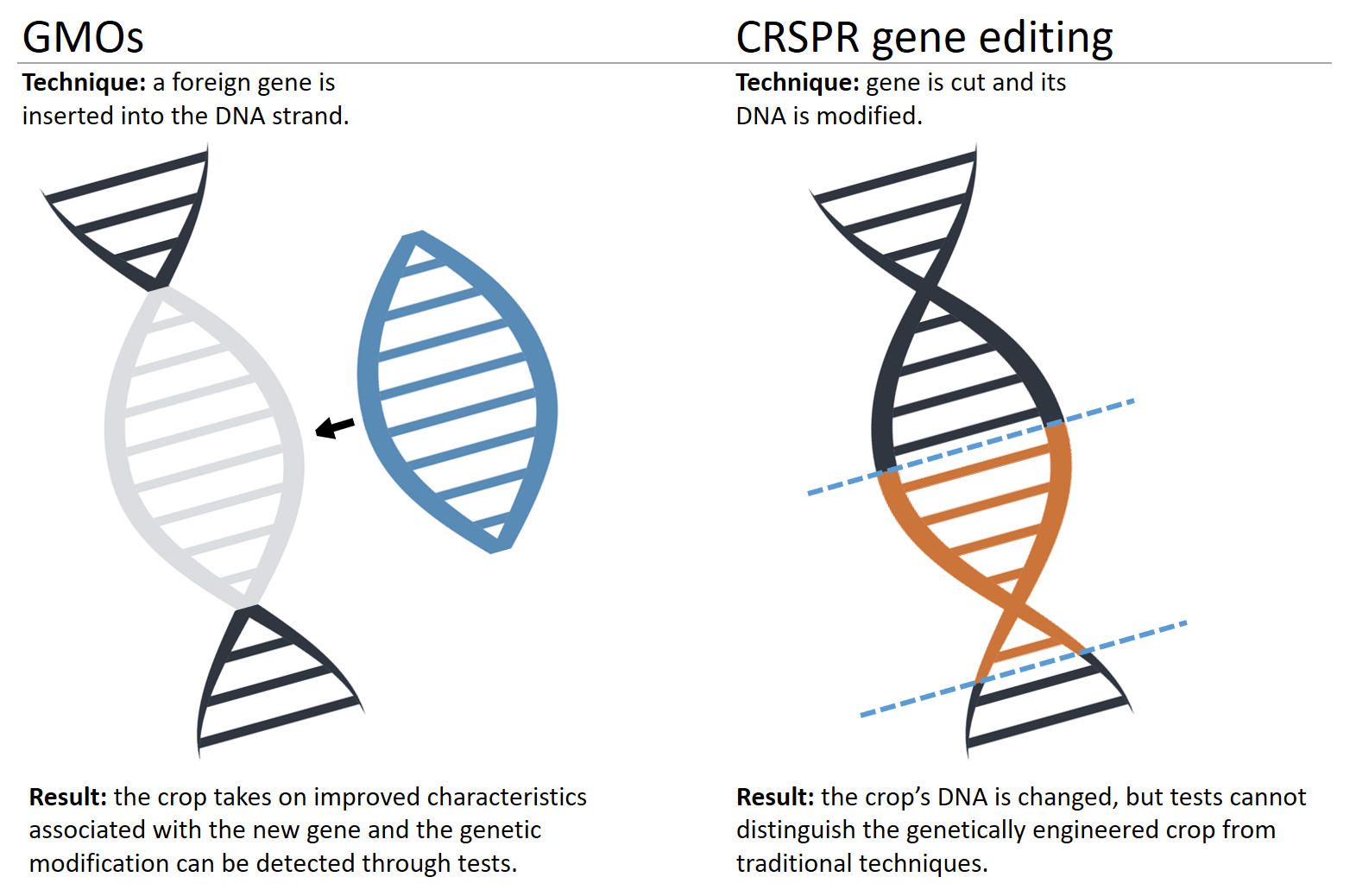Agriculture
Guidelines for Safety Assessment of Genome Edited Plants, 2022
- 21 May 2022
- 10 min read
For Prelims: Genetic Engineering Appraisal Committee, GMO, Genome Editing, DBT, Genetically Modified crops
For Mains: Genetic Engineering
Why in News?
Recently, the Department of Biotechnology (DBT) has issued guidelines easing norms for research into Genetically Modified (GM) crops and circumventing challenges of using foreign genes to change crops profile.
- Earlier, the Government has allowed genome-edited plants without the cumbersome GMO (Genetically Modified Organisms) regulation at the Genetic Engineering Appraisal Committee (GEAC).
What are the Highlights of the Guidelines?
- Exempts Researchers from Seeking Approvals:
- It exempts researchers who use gene-editing technology to modify the genome of the plant from seeking approvals from the Genetic Engineering Appraisal Committee (GEAC).
- The GEAC evaluates research into GM plants and recommends, or disapproves, their release into farmer fields.
- The final call, however, is taken by the Environment Minister as well as States where such plants could be cultivated. The Environment Ministry too has sanctioned this exemption.
- The guidelines provide a road map for the sustainable use of genome editing technologies and applicable to public and private sector research institutions engaged in research and development and handling of genome edited plants.
- It exempts researchers who use gene-editing technology to modify the genome of the plant from seeking approvals from the Genetic Engineering Appraisal Committee (GEAC).
- Issues Guidelines Address:
- Most often, GM plants that have drawn such scrutiny are those that use transgenic technology or introduce a gene from another species into a plant, such as BT-cotton, which uses a soil bacterium gene to protect against pest attack.
- The worry around this method is that these genes may spread to neighbouring plants, where such effects are not intended and so their applications have been controversial.
What is Genome Editing?
- About:
- Genome editing enables modification of plants’ owned genes, without insertion of external genes, as with GM crops.
- Genome-edited varieties possess no foreign DNA and are indistinguishable from crops developed through conventional plant-breeding methods, or using naturally occurring mutations.
- Approaches to Genome Editing:
- Several approaches to genome editing have been developed. A well-known one is called CRISPR-Cas9.
- CRISPR-Cas9 is short for Clustered Regularly Interspaced Short Palindromic repeats and CRISPR-associated protein 9.
- This tool has opened up various possibilities in plant breeding. Using this tool, agricultural scientists can now edit the genome to insert specific traits in the gene sequence.
- Depending on the nature of the edit that is carried out, the process is divided into three categories — SDN 1, SDN 2 and SDN 3.
- Site Directed Nuclease (SDN) 1 introduces changes in the host genome’s DNA through small insertions/deletions without introduction of foreign genetic material.
- In SDN 2, the edit involves using a small DNA template to generate specific changes. Both these processes do not involve alien genetic material and the end result is indistinguishable from conventionally bred crop varieties.
- The SDN3 process involves larger DNA elements or full-length genes of foreign origin which makes it similar to Genetically Modified Organisms (GMO) development.
- Several approaches to genome editing have been developed. A well-known one is called CRISPR-Cas9.
- Global Developments:
- Genome editing is being used in most crop plants for which partial or complete genome sequence is available and is being applied in around 40 crops across 25 countries.
- The US and China are leaders in usage of this technology for developing crop varieties like rice, maize, soybean, canola and tomato which withstand biotic and abiotic stresses arising out of climate change.
What is the Difference between Gene Editing and Genetically Modifying?
- To create genetically modified crops and animals, scientists will typically remove the preferred gene from one organism and randomly introduce it into another organism.
- A well-known genetically modified type of crop is Bt corn and cotton, where a bacterial gene was introduced that produces insecticidal toxins into the part of the plant where the insect eats, causing death to the insect.
- In simple terms, gene editing is a small, controlled tweak to a living organism’s existing DNA versus the introduction of a new, foreign gene.
- It is nearly impossible to detect whether an organism’s DNA has been edited or not because the changes are indistinguishable from naturally occurring mutations.
What is the Significance of the Genome Technique?
- Improve Resistant to Diseases:
- The technology has great promise and emphasis is needed on improving oilseed and pulse crop varieties’ resistant to diseases, insects or pests, and tolerant to drought, salinity and heat stresses.
- Faster Development of Crop Varieties:
- Conventional breeding technique takes 8 to 10 years to develop agricultural crop varieties, while through genome editing, it can be done in two to three years.
What are the Issues with Genome Editing Technique?
- Across the world, GM crops have been a topic of debate, with many environmentalists opposing it on the grounds of bio safety and incomplete data. In India, the introduction of GM crops is a laborious process which involves multiple levels of checks.
- Till date the only crop which has crossed the regulatory red tape is Bt cotton.
- Scientists both in India and across the world have been quick to draw the line between GM crops and genome edited crops. The latter, they have pointed out, has no foreign genetic material in them which makes them indistinguishable from traditional hybrids.
- Globally, European Union countries have bracketed genome edited crops with GM crops. Countries like Argentina, Israel, US, Canada, etc have liberal regulations for genome edited crops.
- Gene editing techniques which involve altering the function of genes and can cause “large and unintended consequences” that can change the “toxicity and allergenicity” of plants.
Way Forward
- In the face of such new advances regarding Genome Technology, the regulatory regime needs to be strengthened as well as rationalised, for the sake of domestic as well as export consumers.
- Technology approvals must be streamlined, and science-based decisions implemented.
- Rigorous monitoring is needed to ensure that safety protocols are followed strictly, and enforcement must be taken seriously to prevent the spread of illegal GM crops.
UPSC Civil Services Examination, Previous Year Questions
Q. With reference to agriculture in India, how can the technique of ‘genome sequencing’, often seen in the news, be used in the immediate future? (2017)
- Genome sequencing can be used to identify genetic markers for disease resistance and drought tolerance in various crop plants.
- This technique helps in reducing the time required to develop new varieties of crop plants.
- It can be used to decipher the host-pathogen relationships in crops.
Select the correct answer using the code given below:
(a) 1 only
(b) 2 and 3 only
(c) 1 and 3 only,
(d) 1, 2 and 3
Ans: D
Exp:
- Chinese scientists decoded rice genome in 2002. The Indian Agricultural Research Institute (IARI) scientists used the genome sequencing to develop better varieties of rice such as Pusa Basmati-1 and Pusa Basmati-1121, which currently makes up substantially in India’s rice export. Several transgenic varieties have also been developed, including insect resistant cotton, herbicide tolerant soybean, and virus resistant papaya. Hence, 1 is correct.
- In conventional breeding, plant breeders scrutinize their fields and search for individual plants that exhibit desirable traits. These traits arise spontaneously through a process called mutation, but the natural rate of mutation is very slow and unreliable to produce all the plant traits that breeders would like to see. However, in genome sequencing it takes less time, thus it is more preferable. Hence, 2 is correct.
- The host-pathogen interaction is defined as how microbes or viruses sustain themselves within host organisms on a molecular, cellular, organism or population level. The genome sequencing enables the study of the entire DNA sequence of a crop, thus it aids in understanding of pathogens’ survival or breeding zone. Hence, 3 is correct.
- Therefore, option (d) is the correct answer








